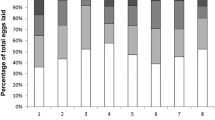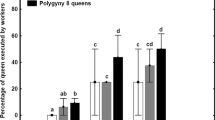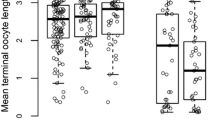Summary
Decrease in individual reproductive output with increasing numbers of reproductives is a general feature of social insect colonies. The previously described negative relationship between the fecundity of individual queens and number of resident queens in polygyne (multiple-queen) colonies of the fire ant Solenopsis invicta appears to result from mutual pheromonal inhibition. In an experimental test for the presence of fecundity reducing pheromones, corpses of functional (egg-laying) queens were found to effectively inhibit the fecundity of functional queens, suggesting that queen-produced pheromones suppress egg production in such queens. Evidence concerning a possible mechanism mediating this inhibition was also obtained. Treatment of queens with methoprene, a juvenile hormone (JH) analog, increased ovary development, suggesting that fecundity in functional queens may be mediated by the level of endogenous JH. These findings are consistent with the occurrence of mutual pheromonal inhibition among queens achieved by suppression of endogenous JH titers.
Similar content being viewed by others
References
Barker JF (1978) Neuroendocrine regulation of oocyte maturation in the imported fire ant Solenopsis invicta. Gen Comp Endocrinol 35:234–237
Bourke AFG (1992) An experimental test of pheromonal inhibition of reproduction among queens in multiple-queen colonies of the ant Leptothorax acervorum. Anim Behav (in press)
Buschinger A (1968) Mono- and Polygynic bei Arten der Gattung Leptothorax Mayr (Hymenoptera, Formicidae). Insectes Soc 15:217–226
Engelmann F (1983) Vitellogenesis controlled by juvenile hormone. In: Downer RGH, Laufer H (eds) Endocrinology of insects (Invertebrate Endocrinology, vol. 1). Alan R. Liss, New York, pp 260–270
Feyercisen R (1985) Regulation of juvenile hormone titer: synthesis. In: Kerkut GA, Gilbert LI (eds) Comprehensive insect physiology, biochemistry and pharmacology (Endocrinology I, vol. 7). Pergamon Press, Oxford, pp 391–429
Fletcher DJC, Blum MS (1981) Pheromonal control of dealation and oogenesis in virgin queen fire ants. Science 212:73–75
Fletcher DJC, Blum MS (1983a) The inhibitory pheromone of queen fire ants: effects of disinhibition on dealation and oviposition by virgin queens. J Comp Physiol A 153:467–475
Fletcher DJC, Blum MS (1983b) Regulation of queen number by workers in colonies of social insects. Science 219:312–314
Fletcher DJC, Blum MS, Whitt TV, Tempel N (1980) Monogyny and polygyny in the fire ant Solenopsis invicta Buren. Ann Entomol Soc Am 73:658–661
Greenberg L, Fletcher DJC, Vinson SB (1985) Differences in worker size and mound distribution in monogynous and polygynous colonies of the fire ant Solenopsis invicta Buren. J Kansas Entomol Soc 58:9–18
Keller L, Nonacs P (1992) The role of queen pheromones in social insects: queen control or queen signal? Anim Behav (in press)
Mercier B, Passera L, Suzzoni J-P (1985) Etude de la polygynie chez la fourmi Plagiolepis pygmaea Latr. (Hym. Formicidae). I. La fécondité des reines en condition expérimentale polygyne. Insectes Soc 32:349–362
Michener CD (1964) Reproductive efficiency in relation with colony size in hymenopterous societies. Insectes Soc 11:317–341
Passera L, Vargo EL, Keller L (1991) Le nombre de reines chez les foums et sa conséquence sur l'órganisation sociale. Année Biol 30:137–173
Rissing SW, Pollock GB (1988) Pleometrosis and polygyny in ants. In: Jeanne RL (ed) Interindividual behavioral variability in social insects. Westview Press, Boulder, Colorado, pp 179–223
Ross KG (1988) Differential reproduction in multiple-queen colonies of the fire ant Solenopsis invicta (Hymenoptera: Formicidae). Behav Ecol Sociobiol 23:341–355
Ross KG (1992) The breeding system of the fire ant Solenopsis invicta, and its effects on colony genetic structure. Am Nat (in press)
Ross KG, Fletcher DJC (1985) Comparative study of genetic and social structure in two forms of the fire ant Solenopsis invicta (Hymenoptera: Formicidae). Behav Ecol Sociobiol 17:349–356
Troisi SJ, Riddiford LM (1974) Juvenile hormone effects on metamorphosis and reproduction of the fire ant, Solenopsis invicta. Environ Entomol 3:112–116
Tschinkel WR (1988) Social control of egg-laying rate in queens of the fire ant, Solenopsis invicta. Physiol Entomol 13:327–350
Tschinkel WR, Howard DF (1978) Queen replacement in orphaned colonies of the fire ant Solenopsis invicta. Behav Ecol Sociobiol 3:297–310
Vargo EL (1988) A bioassay for a primer pheromone of queen fire ants (Solenopsis invicta) which inhibits the production of sexuals. Insectes Soc 35:382–392
Vargo EL (1990) Social regulation of reproduction in fire ant colonies. In: Vander Meer RK, Jaffe K, Cedeno A (eds) Applied myrmecology: A world perspective. Westview Press, Boulder, Colorado, pp 158–172
Vargo EL, Fletcher DJC (1986a) Evidence of pheromonal queen control over the production of sexuals in the fire ant, Solenopsis invicta. J Comp Physiol A 159:741–749
Vargo EL, Fletcher DJC (1986b) Queen number and the production of sexuals in the fire ant, Solenopsis invicta (Hymenoptera: Formicidae). Behav Ecol Sociobiol 19:41–47
Vargo EL, Fletcher DJC (1989) On the relationship between queen number and fecundity in polygyne colonies of the fire ant, Solenopsis invicta. Physiol Entomol 14:223–232
Vargo EL, Passera L (1991) Pheromonal and behavioral queen control over the production of gynes in the Argentine ant Iridomyrmex humilis (Mayr). Behav Ecol Sociobiol 28:161–169
Vargo EL, Ross KG (1989) Differential viability of eggs laid by queens in polygyne colonies of the fire ant, Solenopsis invicta. J Insect Physiol 35:587–593
Vinson SB, Robeau R (1974) Insect growth regulator effects on colonies of the imported fire ant. J Econ Entomol 67:584–587
Willer DE, Fletcher DJC (1986) Differences in inhibitory capability among queens of the ant Solenopsis invicta. Physiol Entomol 11:475–482
Author information
Authors and Affiliations
Rights and permissions
About this article
Cite this article
Vargo, E.L. Mutual pheromonal inhibition among queens in polygyne colonies of the fire ant Solenopsis invicta . Behav Ecol Sociobiol 31, 205–210 (1992). https://doi.org/10.1007/BF00168648
Received:
Accepted:
Issue Date:
DOI: https://doi.org/10.1007/BF00168648




